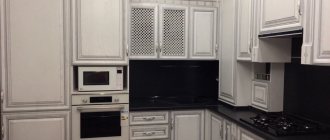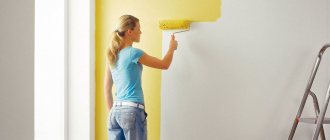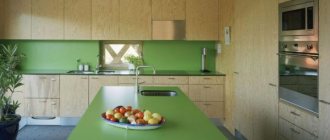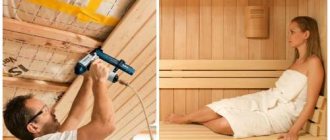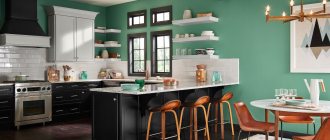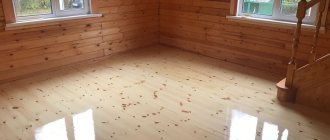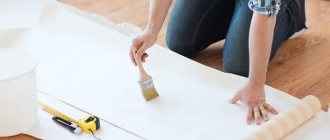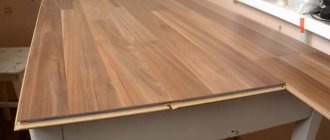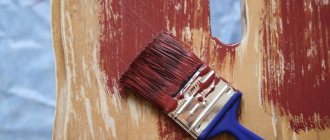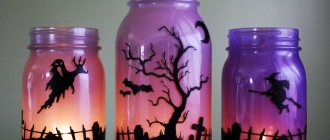Furniture requires protection from external factors. If we are talking about a kitchen set, then it is affected by changes in temperature and humidity. To create a protective barrier, you can apply coloring. Kitchen facades should be painted using suitable paints and varnishes. The process and intricacies of the work will be discussed in detail below.
Necessary tools for painting
They can resort to painting kitchen facades when the old coating has become unsightly and has lost its decorative qualities. It may also be necessary to change the color when renovation work has been done and the shade does not suit the new design. You can decorate by making a unique design.
For work you need to prepare the following tools:
- Rollers and brushes, tool material is selected to match the selected paint. For water-based ones, they are suitable from velor; for varnishes, stains or acrylic types, they are suitable from natural materials;
- A primer mixture is also suitable for paint for kitchen facades;
- Degreasing solvent;
- Sandpaper, felt and wool;
- Construction hair dryer;
- Masking tape;
- Screwdriver;
- Drill;
- Latex gloves.
It is easy to paint wooden and MDF facades.
For work you need to prepare tools.
Preparing materials and tools
To paint kitchen facades with your own hands, we first prepare everything necessary to complete the work. So, in the process of performing all stages of work you will need:
- Sandpaper of varying degrees of grit. It is used to remove old coating or dirt and finish sanding before applying primer or paint. For large and smooth surfaces, you can use a sanding machine.
- Wood putty. It will be needed if, after grinding, chips form on the surface of the part. They must be treated with putty material. Wood is sometimes puttied with a mixture that has an identical color. A similar one can be selected for MDF.
- Product for priming MDF boards. The primer will help to significantly increase the degree of adhesion of the surface of the kitchen facade to the painting material.
- Products to protect skin, eyes and respiratory organs.
- A construction hair dryer that will help to effectively remove the smallest chips from the coating of MDF facades.
- Screwdrivers for convenience when installing and dismantling fittings.
- Paint brushes of different sizes and designs for applying paint. For larger parts, you can use a paint roller.
- Scotch tape used to cover a surface that will not be painted.
- Varnish or, as this composition is also called, glisal. It is used for finishing coating of wooden surfaces, as well as kitchen facades.
Choosing paint composition for kitchen furniture
Repainting should begin with the selection of paint and varnish material; it will affect the final result. Acrylic products are often chosen for various materials, including wood. But in conditions where there is frequent contact with water and temperature exposure, this type does not show the required resistance. Only acrylic paints in spray cans will do.
It is optimal to paint furniture facades with auto enamels; they have the following advantages:
- A durable protective film is created after drying;
- Withstands mechanical stress;
- Durability;
- Rich color palette.
It is optimal to paint furniture facades with auto enamels.
Technology
Tools
The spray gun not only paints, but also primes. There are two types of pistols: pneumatic and electric. The former operate using air pumped by a compressor, and electrical appliances require an appropriate outlet. The nozzle diameter is within 1-1.3 mm and this is enough for uniform spraying.
When buying a roller or brush, be sure to pay attention to the markings, which indicate what composition they are suitable for. For example, a roller with velor bristles is ideal for water-dispersed paints, and natural and combined bristles on the brushes allow stain, acrylic or varnish to adhere well.
Auxiliary materials you will need: gloves, lung protection (mask, respirator), sandpaper of different grain sizes, sanding felt (Scotch-Brite), degreaser or anti-silicone, solvents, masking tape, markers.
How to remove old paintwork
Most often, the top layer on furniture is gloss (varnish or paint). If you do not remove it, the new material will not stick and will not hold. Therefore, the top is treated with the coarsest sandpaper (P220-280). You don’t have to remove all the paint, but simply go over the entire surface to create roughness for better adhesion.
Old coatings can be easily removed with special removers. The most universal are numbers 646 and 647. For acrylic car enamels, R-12 solvent is used. To clean the base enamel, you should purchase a solvent that matches the composition of the base. It is also needed to clean the spray gun and other surfaces from paint residues.
Acrylic compounds are only sanded off. Otherwise there is no way to remove them.
There is another removal option - with a hair dryer (torch). It is suitable for polyester coatings. Under the influence of high temperature, the varnish cracks and is then removed with a spatula or chisel.
Grinding
A perfectly smooth surface is the key to a high-quality coating. This can only be achieved through pre-grinding.
Different grits are required for different sanding steps. From P220 to 280 - this is the preparation of the base for priming. P 320 – removes uneven ground, and P500 is intended for sanding before applying paint.
For finishing and delicate sanding today, Scotch Brite or non-woven felt (with a grain size of P800) is used. It allows for final sanding immediately before painting. Its foam base bends and perfectly handles all unevenness, and an analogue can be found on kitchen sponges.
Painting
The painting itself is not difficult. If you use a can or spray gun, be sure to protect your respiratory tract with a respirator. The device should be located at a distance of 15-20 cm from the facade. Remember that painting translational movements are carried out strictly in one direction.
Paint for MDF furniture facades is applied to completely dry soil and perfectly flat surfaces. For a more concentrated and deeper tone, cover the facades again. The smoothness of the new layer is broken with sandpaper to increase the adhesion of the next one. If you have several colors, then the dried first layer is sealed with masking tape and the paint is applied again.
Applying varnish
Painting furniture facades with MDF varnish usually takes place in one layer of glaze and several layers of paint (maximum 3). In this case, the surface must be completely dry (the same glisal dries for up to 7 days).
The first layer is a barely visible coating, which is needed to avoid drips from the thicker subsequent layers. It is important that the work area is not dusty, otherwise any fluff will be visible in the light. It is for these reasons that painting outside is not advisable.
Each layer of varnish is applied at intervals of up to 10 minutes. And the result of this will be a perfect glossy facade with a mirror effect.
Finishing and decoration
The final sanding of the facades is carried out using P500 sandpaper. The thinnest layer of material is at the ends, so you should work here carefully.
After sanding, go over it again with Scotch Brite. In this case, special care need not be exercised, since the material is soft and does not damage the surface.
Painting kitchen facades is not limited to this; they can be further decorated. This can be the application of regular varnish, glazing (glizal) or polishing. Glizal is a translucent paint for kitchen facades, slightly reminiscent of marble stains. It is diluted with water and applied in several layers.
Patterns on the facade can be created in all sorts of ways (using a damp sponge, a hard brush or a textured roller). But this should be done quickly, as the glisal immediately begins to dry out. At the very end, you should coat the panel again with clear varnish.
There is also this type of decor called “raindrops”. 2 colors are used. Darker paint is applied first. When it hardens, drops of water are sprayed with a regular sprayer. Immediately, without waiting for it to dry, apply the next color with a light spray using a spray bottle. When the paint has dried, the area is sanded with Scotch Brite (P 1200-1500) and varnished.
Paint for facades made of different materials
Before painting your kitchen set, you need to take into account all the nuances of choosing a paint composition. At home. It is important to determine what material the facade is made of: chipboard, MDF, solid wood and others. After all, the paint must be suitable for the material and create good adhesion to it.
It is important to determine what material the facade is made of: chipboard, MDF, solid wood and others.
Solid wood kitchen facades
Solid wood is a durable material that is characterized by wear resistance. The set can last a long time, and if you refresh its color, you can enjoy the furniture for many years. The choice of product is made based on the following criteria:
- Dimensions of the product, if the area is too large, then painting work can be expensive;
- Depending on the texture of the front part, it is better to apply automotive enamel to smooth areas.
Auto enamel will help create a reliable barrier on the tree from external influences.
The set can last a long time, and if you refresh its color, you can enjoy the furniture for many years.
Kitchen facades made of MDF
The paint for kitchen facades made of MDF can be chosen in different ways. This material is not as picky as many others. The choice is made based on budgetary possibilities. But auto enamels are also better suited due to their special stability. You can replace some of the elements using glass. Then the headset will be transformed even more.
The paint for kitchen facades made of MDF can be chosen in different ways.
Plastic kitchen facades
The plastic base is resistant to temperature and moisture. But painting is complicated by poor adhesion of the material. Therefore, you only need to choose compounds that say on the packaging that they are acceptable for working with plastic.
The plastic base is resistant to temperature and moisture.
MDF veneered facades
Veneered MDF is more expensive than usual and belongs to the highest class. It imitates natural wood with high quality, so it looks stylish. It is important to select paint and paint carefully so as not to spoil the set. Acrylic spray paints are fine. And auto enamels will help paint straight areas.
It imitates natural wood with high quality, so it looks stylish.
Selection of composition and application method
What to consider when choosing
- Resistance of the material to dampness - splashes and steam can destroy even a very strong base if its internal voids are open. The structure is destroyed when water is absorbed, the coating expands and cracks. During drying, the fibers and pores shrink, creating deformations that lead to peeling of the finish.
- Resistance to high temperatures - proximity to a hob, oven, or other equipment causes deformation of the top layer and base. Polymer particles do not withstand heat well and begin to melt at temperatures up to 100 degrees. A stream of hot water is enough to render them unusable.
- Resistance to aggressive environments - detergents, powders, acetic acid and substances containing alcohol react with many materials, corroding them and leaving marks on them.
- Durability - Wet rooms are used more heavily than living rooms. Doors and drawers wear out quickly. The coating wears off or receives mechanical damage - dents, chips, scratches. It must have high wear resistance.
- Adhesion - the composition is often selected depending on whether it can be used to repaint glossy kitchen facades. The smoother they are, the better they shine, and the less pronounced the relief on which the enamel can “catch.” Chipboard panels, unlike solid wood, do not have open pores and natural irregularities. They are not able to absorb the solution. As a result, it peels off quickly.
- Environmentally friendly - it is not allowed to use solvents and additives that can be harmful to health. They should not emit harmful substances not only under normal conditions, but also at high humidity and temperatures above room temperature.
- Resistance to ultraviolet rays. Low quality products quickly fade in the sun.
Instagram @nastavetrova
Instagram @nastavetrova
Types of compositions
- Acrylic - they are quickly erased and destroyed under the influence of vinegar and acids contained in products. Acrylic solutions do not tolerate dampness and heat well. If handled with care, they will last a long time if there is no sink or stove nearby. They have a wide palette. Non-toxic. Aerosols and mixtures are available for application by brush and roller.
- Oil-based, alkyd enamel - they are toxic and not intended for areas where food is prepared. Drying oils and varnish create an unpleasant odor even at room temperature. They are a fire hazard. Their performance is worse than that of their analogues. They don't hold up well and take a long time to dry.
- Water-based - easily washed off with water.
- Auto enamel - well suited for damp rooms with constant temperature and humidity changes. Does not fade and withstands loads well. The aerosol strengthens the structure and protects it from destruction, making the surface more elastic. Available only in cans. Colors can be mixed to create new shades.
Only auto enamels are well suited for treating all areas, including problem areas. Acrylic should not be used near the sink or stove. But, if you need to treat parts of the headset that are in a safe environment, it is better to use a spray can.
Color palette
The variety of colors is impressive, you can easily choose the desired shade. There are ready-made shades that can be mixed if necessary to obtain the desired shade. Pigments can be added to the white base color to achieve the tone you like. There are also additives that provide the following effects:
- Matte, this option is usually chosen for furniture;
- Chameleon You can paint all the cabinets in the set, but stick to one tone so as not to overload with color, because the effect is complex. It is advisable that the shade be still somewhere in the interior;
- Gloss is also popular;
- Mother of pearl, experts recommend using it as an accent solution;
- Glow, looks stylish;
- Shimmering.
In order for the shade to turn out well, it is important to monitor the density of the layer and also dry it under natural conditions. Then the paint will adhere securely.
Be sure to read the instructions from the manufacturer, where the nuances of application may be prescribed.
The variety of colors is impressive, you can easily choose the desired shade.
Types of coatings
Kitchen fronts are the front parts of cabinets with doors and drawers. They can be solid or prefabricated, with swinging, sliding, lifting structures or accordion-folding ones. When choosing a kitchen set, first of all, pay attention to the physical characteristics of the material: moisture resistance, fire resistance, strength, etc. However, over time, any product loses its former attractiveness due to long-term use, sunburn, and mechanical damage. Then the question arises, is it possible to update the kitchen façade with your own hands? Before you start work, you should understand the features of the material from which the facade is made.
- Kitchen furniture made of wood attracts with its environmental friendliness and luxury, and also fits perfectly into classic and modern interiors. In order to preserve the original appearance of the product, special care and periodic restoration are required so that pests do not destroy the wood, and the doors do not become deformed due to moisture.
- Laminated chipboard is an inexpensive option, but completely impractical. Chipboard has a loose structure, which causes the material to swell in a humid environment.
- MDF facades are the most popular and versatile due to the durability of the material and a wide selection of colors. MDF facade panels can be either simple, flat, or rounded and asymmetrical.
- Plastic has the longest service life. It is applied to an MDF panel, sometimes chipboard. Such facades are not afraid of moisture, steam, temperature changes and aggressive household chemicals. Painting them is the most difficult, since it is difficult to select the necessary consumables.
- A set with glass inserts looks rich and luxurious, and never goes out of style. Glass is usually inserted into an aluminum profile or MDF panel, although there are also frameless structures, where the entire load falls exclusively on high-quality and durable fittings. To update the facade, you can use stained glass paint, with which you can create a unique pattern or design.
Surface preparation and painting algorithm
Before painting the kitchen set with your own hands, the furniture is prepared. It is necessary to remove all fittings; it is better to remove the doors from the cabinets.
The old finish is removed to improve adhesion and leave a clean surface. Extra elements will not allow the layer to lie flat. The base is degreased. After the material is leveled, the cracks are puttied.
The old finish is removed to improve adhesion and leave a clean surface.
Caring for furniture after painting
Factory painting is always more durable than do-it-yourself painting. This means that you need to use the repainted kitchen unit more carefully. It will not benefit from contamination with grease, since when washed there is a high probability of washing off the paint. Similarly, painted surfaces suffer from bright sunlight and the use of household detergents. Exposure to steam and high temperature causes bubbles to appear.
If handled carelessly, the repainted furniture will soon need to be restored again. It is recommended to wipe the facades with dry wipes as often as possible to remove moisture and grease splashes. If there is some kind of defect in the design - a deep scratch, puncture, crack, chip, then in the future such a loophole will become the starting point for the destruction of the furniture.
It is important to consider the angle of incidence of sunlight from the window. If it falls directly on the facades, then it is worth hanging curtains or blinds to protect the set from fading. For everyday washing, you should not use abrasive powders - only soft liquid products recommended for caring for the selected type of paint. The presence of a powerful modern hood in the kitchen significantly extends the service life of a repainted set.
Painting your kitchen furniture can be the most exciting part of the entire renovation. The beauty is that until the very completion of the work it is difficult to imagine exactly how the set will look. Well, if you don’t like it, you can always redo it.
Grinding
When the putty solution dries well, the base is brought to perfection. Use coarse sandpaper and sand the surface until it is smooth. Then replace the sandpaper with a smaller version so that the smoothness becomes better.
It is optimal to choose the sandpaper grain numbers P400 or P600.
When the putty solution dries well, the base is brought to perfection.
Common mistakes
The technology requires appropriate humidity (no more than 50%) and temperature (no lower than 20°C and no higher than 24°C). Therefore, paint and varnish work should be carried out indoors using lung protection.
The easiest way to change is the light base of the surface. When using stain (for wood) or colored varnish, you will get a darker facade, but at the same time maintain the structure of the material. If your base is dark, then it is more difficult to emphasize its structure.
The easiest way to get the desired tone is by mixing the desired colors several times in different dishes. Check the result on test surfaces and when the paint has dried, you will be able to make a more accurate choice.
Source
Primer
Priming is necessary so that the layer adheres well to the surface, and the composition will also help remove remaining flaws. You need to select a primer solution based on the type of wooden material that will be primed. The tool is a roller or brush, drying will take approximately 24 hours.
Priming is necessary so that the layer adheres well to the surface, and the composition will also help remove remaining flaws.
Replacing or painting kitchen furniture, what to do?
DIY is one of the fastest growing trends . Renovating old kitchen furniture, or rather painting it, which has already seen its best years, is a positive trend that dates back to the good times when do-it-yourself was at a premium and individual appliances were respected. Better to repair than throw away, refresh rather than replace, right? Moreover, we will always have time to buy a new one, if only we had the money, as they say. And the easiest and most effective way to give your kitchen a neat look is to paint it with high-quality paint. We will discuss how to do this correctly in this article, step by step, in 6 simple steps.
Kitchen furniture wears out the fastest. High intensity of use, exposure to grease, stains, exposure to water vapor and, finally, the risk of damage means that after a few years we may notice more or less serious scratches or abrasions on the fronts of drawers and cabinets. On the other hand, such minor imperfections do not necessarily mean they need to be replaced. Kitchen paint is often a much better (and definitely cheaper!) way to replace it. Simply applying a few coats, replacing handles or countertops can make a big difference in your kitchen design.
If you decide to repaint your kitchen set and decide what color it will be, be prepared for the fact that you will have to change the textiles on the windows and the upholstery material on the upholstered furniture
Facade painting
How the paint and varnish material will be applied is decided based on the task at hand and the color of the composition. But first of all, in any case, the ends of the parts are painted.
If you choose a spray gun as a tool and have no experience working with it, then it is advisable to try painting on an unnecessary object. It's also useful to do this after setting up the tool to make sure the settings are correct.
The coating is usually done in multi-layers, three are usually enough, but sometimes they decide to do more to get a rich layer. Each new layer is applied after 10-15 minutes for setting to occur. If they paint dark wood in a light tone, its texture will be completely obscured and the design will not be preserved.
The coating is usually done in multi-layers, three are usually enough, but sometimes they decide to do more to get a rich layer.
How to paint a facade correctly - more detailed stages of work
Preparation
The first step is to remove the facades from their hinges to make them easier to process. Cover the hinges with tape to prevent paint or primer from getting on them.
If the facades are made of chipboard, then it is necessary to remove the PVC film, which is the top covering of such furniture. Remove this film using a hair dryer. Don't forget to put on gloves and a respirator first: the melted film can emit a toxic odor. Remove the film carefully - it is best if not a piece of it remains at all.
After this, wipe the surface and remove dust from it.
Grinding
You can sand the surface of the facades using sandpaper or a special machine, if you have one. Sanding also removes old paint from MDF facades. If it is not possible to remove the old coating by sanding, then you can use special solvents to make the task easier.
After the facades have been cleaned and sanded, carefully remove all dust from them. And degrease. Dust can be removed with a damp sponge, and degreased with a solvent.
Primer
For this work, use a special composition intended for wood. If your kitchen fronts include plastic parts, then purchase your own composition for them, specifically designed for plastic. Before using the primer, shake it thoroughly to distribute the components more evenly.
To obtain a more even surface, the primer can be applied to the wooden facade in two layers. After each layer, you must wait for it to dry completely before applying the next one.
To speed up and simplify the priming process, you can use special aerosol compositions - they are very convenient to apply and are evenly distributed over the surface. After you have thoroughly treated the surfaces with a primer, you need to wait a day before painting the wooden facade.
Painting
To thoroughly paint kitchen facades without gaps or bald spots, paint twice. Apply paint in one direction. If you use several shades, carefully cover the transition border with tape so that the borders are clear.
You can add color to the surface using cans containing paint - in this case, the painted facade will look more professionally processed, since the coating will be distributed evenly. However, there is a danger that the paint will get on nearby surfaces, so they must first be protected with newspapers, paper or polyethylene.
If you are painting facades from an aerosol can, then before you start spraying, do not forget to shake the can thoroughly so that the paint inside it acquires a uniform color and consistency. It is necessary to apply 2-3 layers of paint. After each layer, wait until it dries completely. The average drying time is always indicated on the paint can.
Glizal
After the paint has dried, glisal is applied to give a decorative shine. This composition is prepared according to the instructions and applied to the painted surfaces with light movements. After drying, the updated facades can be installed in place. If you want to get matte facades, then do not use glisal.
If you want to create a shiny kitchen surface with your own hands without the streaks that are inherent in glazed paint, then coat the facades with varnish. Do not forget that this product has a very strong odor, so it is better to work with the windows open. You can paint MDF facades and others with varnish of any tone: shiny glossy or calm matte.
Finishing and decorative processing
The process should be completed by polishing. Use sandpaper to remove defective parts, then use linen cloth impregnated with special products and polish the furniture. In order for the effect to be high-quality, the application is done quickly, and in three layers, each must dry for 12 hours.
Decoration is carried out on a dried coating, and finally the surface is treated with finishing compounds. There are the following options for decoration:
- Creating an aged coating. Patinated material is used, which is spread over the cabinet using a sponge or brush. Next, the surface is polished;
- Decoupage, the effect is obtained using the decoupage technique;
- You can draw a variety of patterns; for this you need stencils; there are ready-made templates for sale, or you can make them yourself;
- Chaotic irregularities and patterns can attract the eye. To create them, you can simply apply paint with a sponge, stamps, brushes, etc.;
- You can combine several colors, highlighting textured details, you can also paint the inside and outside in different tones, highlight the ends;
- Sometimes they resort to decorative details. Pebbles, rhinestones, etc. are glued on.
There are no restrictions in terms of decor, you shouldn’t overdo it, but you can show your imagination. And create an original design, not forgetting about the skillful implementation of the idea into the overall interior.
Patinated material is used, which is spread over the cabinet using a sponge or brush.
Glisal treatment
To give painted facades originality, the painted surface is given a non-standard structure. For this purpose, glisal is used to change the structure of the facades. Let's take a closer look at the technique of applying glisal:
- Let the painted facades dry completely.
- We dilute glisal with water strictly according to the manufacturers' instructions.
- Using a clean brush, apply the solution to the painted surface.
Next, let's get creative. The surface of the glitz can be treated with a piece of foam rubber or multidirectional brush strokes. Using crumpled polyethylene you can get chaotic broken patterns.
If the result of the work does not meet the consumer's expectations, then this can be corrected. We apply a new thin layer of glaze and try again to diversify the structure of the facades.
Glizal is quite convenient to work with, as it takes longer to dry than paint or varnish. Therefore, there is no need to rush, but rather do the work carefully. The painted parts are dried for about a day.
Important! To extend the service life of painted facades, you can cover them with a protective layer of varnish.
So, as we see, a painted MDF facade can be transformed quite quickly, and without involving craftsmen. You just need to show persistence and diligence, and the new MDF kitchen design in the house will very soon please the residents.
MDF painting technology (1 video)
Materials for painting MDF (34 photos)
Is it possible to repaint the façade?
It is possible to repaint the facade, but it is important to thoroughly clean it of the old finish. So that poorly adhering paint does not create defects that will be very noticeable on the new layer. Also, an old smooth coating will make it difficult for the elements to adhere; you need to get a rough base, then the quality of the paint will be high.
It is possible to repaint the facade, but it is important to thoroughly clean it of the old finish.
Nuances of decoupage technique
A technology called decoupage allows you to get an unusual set using the simplest means. With its help, you can repaint facades made of any materials, the main thing is the original design and its precise execution.
Facades using decoupage technique
A beautiful picture is not drawn by hand. The printed image is used to transfer to a tabletop, the back of a chair or the front of a cabinet. Beautiful drawings especially for decoupage can be bought in a specialized store - they are called cards. Other images will also work - cut out from magazines, printed on a printer, even beautiful napkins.
Before decorating the furniture with a beautiful image, you need to paint it in the main color. Decoupage work is carried out in several stages:
- The picture is carefully glued into place. For this, regular PVA glue is used.
- After waiting for the glue to dry completely, the entire surface must be evenly coated with transparent varnish.
You can select a drawing in different ways. For example, paste special moldings along the chalk outline of the image to get a frame effect.
You can duplicate the design from the facade of the set on the countertop, decorative cutting boards and other elements of the kitchen interior.
Decoupage of the dining group
How to remove old paintwork
To make it easier to remove the previous layer, you can heat it with a hair dryer, then the adhesion decreases and the layer itself comes off a little. There are also special washes on sale, but you need to remember that they have a strong smell, and you need to wear a respirator and create effective ventilation when working inside a building.
Or you can use sandpaper; you can use it to remove the layer, but the process will not be quick. A lot of dust is also generated to make the process easier; it is vacuumed regularly. Make sure not to touch the façade material itself and not lose the desired evenness. This method is used if other options are not available.
Not in all cases it is necessary to remove the entire layer; sometimes it is enough to ensure roughness to obtain optimal adhesion. But only if the paint holds well.
To make it easier to remove the previous layer, you can heat it with a hair dryer, then the adhesion decreases and the layer itself comes off a little.
Repainting the kitchen facade will help to update the interior of the room on a budget, because the kitchen set is one of the important elements in this area. You need to choose high-quality paint so as not to spoil the furniture and get a beautiful design. You can carry out the work yourself, the main thing is to follow the painting technology. Do not neglect the preparatory part so that the paint lays evenly and no flaws remain.
Why paint the kitchen furniture
First of all, updating the shade of furniture facades helps to bring something special and unique into the interior. The most beautiful samples displayed in the windows of furniture stores often evoke a feeling of annoyance: everyone can buy exactly the same set, that is, there is no individuality or zest in it.
No matter how hard the owners try to achieve a pre-planned result in the process of repainting existing furniture, in reality it always turns out a little wrong. But that’s the beauty of creativity. Sometimes the result exceeds expectations, and sometimes it differs dramatically from plans, but you still like it.
There are also more significant advantages to a creative approach to kitchen renovation:
- radical transformation of the interior with a minimum of financial investments (you just need to buy paint);
- the entire amount of work can be done alone, without attracting anyone to help, but nothing prevents you from involving all family members in the process, thereby giving everyone a chance to feel like a creator;
- the scope for realizing your most daring ideas is unlimited - from minimalism to French Provence or Rococo, because you can not only paint it one color, but also apply an ornament, glue tiles, and add zest using the decoupage technique.
Changing an old boring color to a new one - what could be easier
? There are no restrictions on the type of material from which kitchen facades are made. For any surface, you can, if desired, find the appropriate paint. The main thing is to choose a suitable beautiful color.
How much does it cost to repaint a kitchen?
We decided to dedicate this page to such a popular topic as kitchen repainting. And everyone is naturally interested in the question of how much it costs to repaint a kitchen. We repaint kitchens from 2,500 rubles per 1 square meter of kitchen area. We immediately answered the main question “how much does it cost to paint (repaint) a kitchen”, so as not to take up a lot of your time. For those who are still interested in learning a little more, we have prepared a short article. So, let's begin…
Repainting the kitchen
Care
In exchange for numerous advantages, acrylic facades require proper care. In such a kitchen, both glossy and matte, splashes, drops and stains will be noticeable. You will have to clean the kitchen frequently. At least once a week, it is necessary to clean the surface of the facades from greasy marks, fingerprints and other contaminants using a soft microfiber cloth using grease-repellent gels.
It is worth noting that abrasive agents are absolutely contraindicated for this material. Cleaning should be done only with gentle products.
You will have to maintain the glossy shine daily. To do this, you need to use rags made of soft materials and products for glass and mirror surfaces that do not contain alcohol or acetone.
Thus, a kitchen with acrylic facades has numerous advantages compared to other materials. Its main feature is the increased requirement for care. However, reviews from real buyers on the Internet say that “the game is worth the candle.” The stylish, bright appearance of the kitchen and its practicality overshadow the disadvantages in the form of maintenance features and the high cost of the set.
